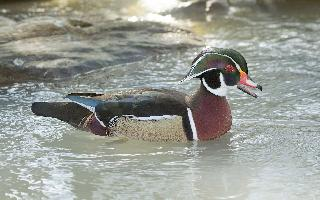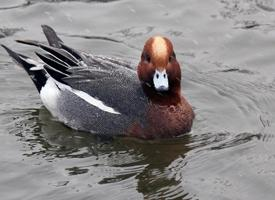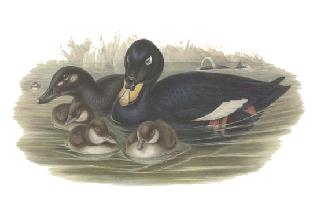
Poids et mesures
| Longueur | 48 cm |
|---|---|
| Envergure des ailes | 73 cm |
Description de l'animal
The Wood Duck, scientifically known as Aix sponsa, is a captivating and vibrantly colored waterfowl species that is a favorite among bird watchers and nature enthusiasts alike. This species is native to North America and is particularly notable for its striking appearance and unique behaviors. The Wood Duck is a medium-sized bird, with males typically showcasing more vibrant colors than their female counterparts.Males, or drakes, are adorned with iridescent plumage that features a mesmerizing blend of greens, blues, and purples, making them one of the most visually striking ducks in North America. Their heads are decorated with bold white stripes and a distinctive crest, while their bodies are covered in a pattern of intricate markings that include spots, stripes, and patches of color. The female Wood Duck, though more subdued in color, is no less beautiful. She boasts a warm, mottled brown plumage that allows her to blend seamlessly into the woodland habitats she frequents, with a distinctive white teardrop-shaped patch around her eye.
Wood Ducks are unique among ducks in their nesting habits. Unlike most waterfowl that nest on the ground, Wood Ducks seek out the safety of tree cavities or nest boxes near water bodies to lay their eggs. This adaptation allows them to protect their offspring from predators. After the ducklings hatch, they face the daunting task of making their way to the water, which can involve leaping from the nest to the ground below, sometimes from considerable heights.
The diet of the Wood Duck is varied and includes seeds, fruits, insects, and aquatic plants. They are often seen foraging in shallow waters, dabbling at the surface or tipping forward to reach underwater vegetation. Their adaptability in diet and habitat has helped them thrive in a variety of environments, though they prefer wooded swamps, marshes, streams, and ponds, where there is ample vegetation for cover.
The Wood Duck is a species that has faced challenges in the past, including habitat loss and overhunting, which led to significant declines in their population. However, through conservation efforts, including the provision of nesting boxes and habitat restoration, their numbers have rebounded, and they are now considered a conservation success story.
In terms of behavior, Wood Ducks are known for being somewhat shy and elusive, often retreating to the cover of dense vegetation at the first sign of disturbance. They are strong fliers, capable of weaving through trees and vegetation with remarkable agility. During the breeding season, the males perform elaborate courtship displays that include vocalizations and physical posturing to attract a mate.
The call of the Wood Duck is another characteristic that sets it apart. Males emit a high-pitched, whistling sound, while females produce a more guttural, quacking call. These calls play a vital role in communication among Wood Ducks, especially during the breeding season.
In summary, the Wood Duck (Aix sponsa) is a stunning example of North America's avian diversity, known for its brilliant plumage, unique nesting habits, and successful recovery from the brink of decline. Its presence enhances the natural beauty of wetland habitats, making it a cherished species among those who appreciate the great outdoors.
Animaux similaires
Nouvelles photos d'animaux
Top 10 des animaux
- Dolphin gull (Leucophaeus scoresbii)
- Japanese macaque (Macaca fuscata)
- Stone loach (Barbatula barbatula)
- Greek tortoise (Testudo graeca)
- Russian tortoise (Testudo horsfieldii)
- Galápagos tortoise (Geochelone nigra complex)
- Diana monkey (Cercopithecus diana)
- Moustached guenon (Cercopithecus cephus)
- Common flying dragon (Draco volans)
- Galápagos penguin (Spheniscus mendiculus)


